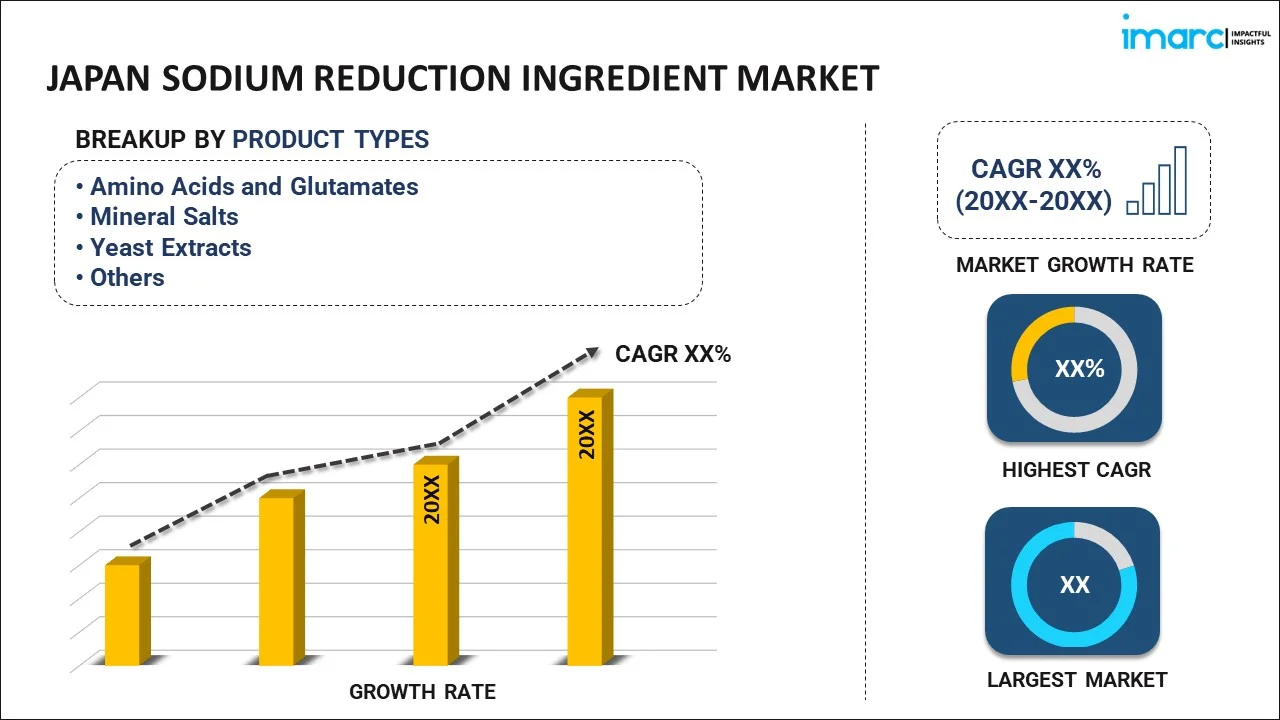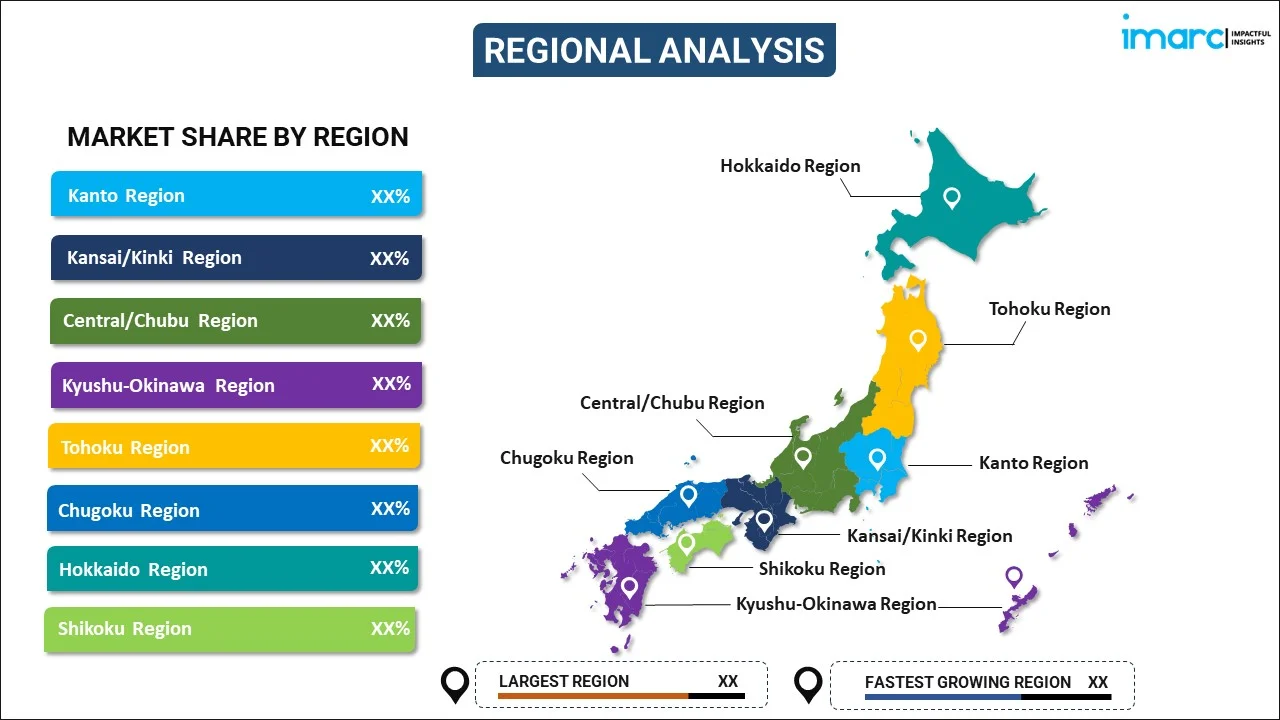
Japan Sodium Reduction Ingredient Market Report by Product Type (Amino Acids and Glutamates, Mineral Salts, Yeast Extracts, and Others), Application (Bakery and Confectionery, Condiments, Seasonings and Sauces, Dairy and Frozen Foods, Meat and Seafood Products, Snacks and Savory Products, and Others), and Region 2025-2033
Market Overview:
Japan sodium reduction ingredient market size reached USD 329.0 Million in 2024. Looking forward, IMARC Group expects the market to reach USD 446.0 Million by 2033, exhibiting a growth rate (CAGR) of 3.4% during 2025-2033. The rising consumer health consciousness, along with the introduction of specialized product variants, including low-sodium salt, cereals, flour, grains, etc., is primarily driving the market growth.
|
Report Attribute
|
Key Statistics
|
|---|---|
|
Base Year
|
2024 |
|
Forecast Years
|
2025-2033
|
|
Historical Years
|
2019-2024
|
| Market Size in 2024 | USD 329.0 Million |
| Market Forecast in 2033 | USD 446.0 Million |
| Market Growth Rate (2025-2033) | 3.4% |
Sodium reduction ingredients are crucial constituents in food processing, purposed to decrease and regulate high-sodium content in consumables. These components are essential in formulations that necessitate controlled salt presence, such as those stemming from health-conscious dietary choices or specific nutritional needs. Sodium reduction ingredients are instrumental in endeavors like diminishing the risk of hypertension, maintaining balanced electrolyte levels, and in salt substitution for specific health protocols. The advantages of integrating these substances are numerous, as they foster health and are decisive in meticulously moderating and substituting sodium content, initiating healthier food alternatives. Sodium reduction ingredients are especially significant in the advancement of dietary trends focused on cardiovascular health, playing a foundational role in aligning with low-sodium and salt-restricted dietary recommendations. Hence, these ingredients are vital in advancing culinary innovations and improving health metrics in processed foods, leading to the creation of nutritious, wellness-oriented consumables.
Japan Sodium Reduction Ingredient Market Trends:
The Japan sodium reduction ingredients market is undergoing significant transformation, with notable trends and influential factors guiding its trajectory. A chief motivator is the mounting concern for health and wellness, due to the rising prevalence of lifestyle-related diseases. Furthermore, consistent advocacy by public health organizations acts as a pivotal element, stressing the importance of reduced sodium intake to counteract issues like hypertension and cardiovascular diseases, which demand attentive dietary management. Moreover, the escalating popularity of processed foods is a primary trend, where the inclusion of these ingredients is vital for balancing taste while ensuring nutritional standards, bridging the gap between flavor preference and health imperatives. The strides in food technology and the urgent call for healthier eating habits are also propelling the market, challenging food innovators to find alternatives that satisfy both palate and well-being. The regional market benefits immensely from heightened awareness and educational campaigns, emphasizing the adoption of low-sodium and balanced dietary patterns. In summation, varied consumer preferences, technological breakthroughs, and the increasing emphasis on health-centric solutions are expected to bolster the Japan sodium reduction ingredients market in the coming years.
Japan Sodium Reduction Ingredient Market Segmentation:
IMARC Group provides an analysis of the key trends in each segment of the market, along with forecasts at the country level for 2025-2033. Our report has categorized the market based on product type and application.
Product Type Insights:

- Amino Acids and Glutamates
- Mineral Salts
- Yeast Extracts
- Others
The report has provided a detailed breakup and analysis of the market based on the product type. This includes amino acids and glutamates, mineral salts, yeast extracts, and others.
Application Insights:
- Bakery and Confectionery
- Condiments, Seasonings and Sauces
- Dairy and Frozen Foods
- Meat and Seafood Products
- Snacks and Savory Products
- Others
A detailed breakup and analysis of the market based on the application have also been provided in the report. This includes bakery and confectionery, condiments, seasonings and sauces, dairy and frozen foods, meat and seafood products, snacks and savory products, and others.
Regional Insights:

- Kanto Region
- Kansai/Kinki Region
- Central/ Chubu Region
- Kyushu-Okinawa Region
- Tohoku Region
- Chugoku Region
- Hokkaido Region
- Shikoku Region
The report has also provided a comprehensive analysis of all the major regional markets, which include Kanto Region, Kansai/Kinki Region, Central/ Chubu Region, Kyushu-Okinawa Region, Tohoku Region, Chugoku Region, Hokkaido Region, and Shikoku Region.
Competitive Landscape:
The market research report has also provided a comprehensive analysis of the competitive landscape in the market. Competitive analysis such as market structure, key player positioning, top winning strategies, competitive dashboard, and company evaluation quadrant has been covered in the report. Also, detailed profiles of all major companies have been provided.
Japan Sodium Reduction Ingredient Market Report Coverage:
| Report Features | Details |
|---|---|
| Base Year of the Analysis | 2024 |
| Historical Period | 2019-2024 |
| Forecast Period | 2025-2033 |
| Units | Million USD |
| Scope of the Report | Exploration of Historical Trends and Market Outlook, Industry Catalysts and Challenges, Segment-Wise Historical and Future Market Assessment:
|
| Product Types Covered | Amino Acids and Glutamates, Mineral Salts, Yeast Extracts, Others |
| Applications Covered | Bakery and Confectionery, Condiments, Seasonings and Sauces, Dairy and Frozen Foods, Meat and Seafood Products, Snacks and Savory Products, Others |
| Regions Covered | Kanto Region, Kansai/Kinki Region, Central/ Chubu Region, Kyushu-Okinawa Region, Tohoku Region, Chugoku Region, Hokkaido Region, Shikoku Region |
| Customization Scope | 10% Free Customization |
| Post-Sale Analyst Support | 10-12 Weeks |
| Delivery Format | PDF and Excel through Email (We can also provide the editable version of the report in PPT/Word format on special request) |
Key Questions Answered in This Report:
- How has the Japan sodium reduction ingredient market performed so far and how will it perform in the coming years?
- What has been the impact of COVID-19 on the Japan sodium reduction ingredient market?
- What is the breakup of the Japan sodium reduction ingredient market on the basis of product type?
- What is the breakup of the Japan sodium reduction ingredient market on the basis of application?
- What are the various stages in the value chain of the Japan sodium reduction ingredient market?
- What are the key driving factors and challenges in the Japan sodium reduction ingredient?
- What is the structure of the Japan sodium reduction ingredient market and who are the key players?
- What is the degree of competition in the Japan sodium reduction ingredient market?
Key Benefits for Stakeholders:
- IMARC’s industry report offers a comprehensive quantitative analysis of various market segments, historical and current market trends, market forecasts, and dynamics of the Japan sodium reduction ingredient market from 2019-2033.
- The research report provides the latest information on the market drivers, challenges, and opportunities in the Japan sodium reduction ingredient market.
- Porter's five forces analysis assist stakeholders in assessing the impact of new entrants, competitive rivalry, supplier power, buyer power, and the threat of substitution. It helps stakeholders to analyze the level of competition within the Japan sodium reduction ingredient industry and its attractiveness.
- Competitive landscape allows stakeholders to understand their competitive environment and provides an insight into the current positions of key players in the market.
Need more help?
- Speak to our experienced analysts for insights on the current market scenarios.
- Include additional segments and countries to customize the report as per your requirement.
- Gain an unparalleled competitive advantage in your domain by understanding how to utilize the report and positively impacting your operations and revenue.
- For further assistance, please connect with our analysts.
 Inquire Before Buying
Inquire Before Buying
 Speak to an Analyst
Speak to an Analyst
 Request Brochure
Request Brochure
 Request Customization
Request Customization




.webp)




.webp)












